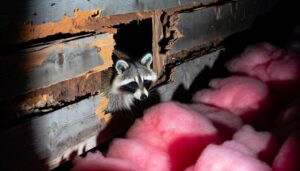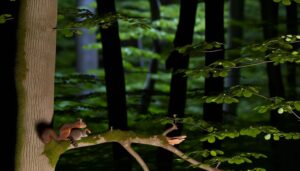Do Raccoons Live in Asia: Exploring Their Habitats
Raccoons, originally native to North America, have established populations in various parts of Asia due to human introductions. Initially brought to Asia via the pet trade and zoological collections in the early 20th century, raccoons have adapted well to new environments.
Countries like Japan, South Korea, and parts of China report increasing sightings, particularly in suburban and rural areas. These introductions have ecological implications, including competition with native species and potential disease transmission.
Evidence from camera trap surveys supports their growing presence. This adaptability and its consequences highlight important biological and ecological considerations worth exploring further.

Key Takeaways
- Raccoons were introduced to Asia in the early 20th century through the pet trade and zoological collections.
- They have established feral populations in countries like Japan, South Korea, and parts of China.
- Recent surveys indicate an increasing presence of raccoons in suburban and rural areas across Asia.
- Their adaptability and high reproductive rates facilitate their successful colonization in new environments.
- Raccoons pose ecological risks by preying on native species and acting as disease vectors.
Native Habitat of Raccoons

Raccoons (Procyon lotor) inhabit regions across North America, especially within deciduous and mixed forests. These habitats provide ample food sources, including fruits, nuts, and small animals, essential for their omnivorous diet.
Raccoons are highly adaptable, also thriving in urban and suburban environments where they exploit human-derived food resources. Studies indicate their population densities can reach up to 50 individuals per square kilometer in best conditions.
Preferred nesting sites include hollow trees and abandoned burrows, offering protection from predators and harsh weather. Seasonal variations influence their activity patterns, with reduced activity observed during winter months.
Understanding the ecological preferences and behaviors of raccoons in their native habitats is essential for effective wildlife management and conservation efforts.
Early Introductions to Asia
The initial introduction of Procyon lotor to Asia occurred in the early 20th century, primarily through the exotic pet trade and zoological collections. Historical records indicate that raccoons were imported for display in zoos and as novel pets, sparking interest among local populations.
By the mid-20th century, intentional and accidental releases led to the establishment of small, feral populations. The adaptability of raccoons to diverse environments facilitated their survival outside captivity. According to zoological surveys, these early introductions were not widespread but localized, mostly in urban areas where zoos and pet owners were concentrated.
Genetic studies suggest these populations were not initially significant in number but exhibited high reproductive rates, enabling a gradual increase over subsequent decades.
Modern-Day Sightings

Recent surveys and ecological studies reveal that raccoon sightings in Asia have become increasingly frequent, particularly in suburban and rural areas. Data collected from regions such as Japan, South Korea, and parts of China indicate a growing presence of raccoons, often linked to their adaptability and opportunistic feeding habits.
For instance, a 2022 study in Japan reported a 20% increase in raccoon encounters over the past five years. Additionally, camera trap surveys in South Korea have documented raccoons in 15 out of 18 surveyed rural districts. These sightings underscore the species' ability to thrive in diverse environments, raising concerns about potential ecological impacts and the need for effective wildlife management strategies.
Methods of Arrival
Several pathways have facilitated the introduction of raccoons into Asian ecosystems, including both intentional releases and accidental escapes from captivity. Intentional releases often stem from the pet trade, where raccoons are imported for private ownership and subsequently released into the wild due to challenges in maintaining them.
Additionally, raccoons have escaped from zoos and private enclosures, thereby establishing feral populations. Data suggest that raccoons were first introduced to Japan in the 1970s, correlating with the popularity of raccoons as pets following the animated series 'Rascal the Raccoon.' Unintended transport via shipping containers and other trade mechanisms has also contributed to their presence. These methods collectively explain the presence of raccoons in various Asian regions today.
Impact on Local Ecosystems

The introduction of raccoons into Asian ecosystems has led to significant disruption of native species, particularly through predation and habitat alteration. Additionally, raccoons compete with indigenous wildlife for limited resources such as food and nesting sites, which can lead to declines in native population numbers.
Empirical data from various studies underscore the breadth of these ecological impacts, necessitating further research and management strategies.
Disruption of Native Species
Introduction of raccoons into Asian ecosystems has led to significant disruptions in native species populations and local biodiversity.
Raccoons, being opportunistic omnivores, prey on a wide range of native fauna, including insects, amphibians, and small mammals. This predation pressure can lead to declines in these native populations, as evidenced by studies documenting reduced numbers of amphibian species in raccoon-inhabited areas.
Additionally, raccoons can act as vectors for diseases such as rabies and canine distemper, which can further impact native species. The alteration of food webs and increased disease transmission disrupts ecological balances, leading to cascading effects on biodiversity.
Consequently, the presence of raccoons in non-native habitats represents a considerable threat to local ecosystems and their endemic species.
Competition for Resources
Raccoons compete directly with native species for essential resources such as food, water, and shelter, thereby imposing additional stress on local ecosystems. This competition can lead to significant ecological imbalances. Data shows that raccoons, as generalist feeders, adapt quickly to available food sources, thereby depriving native fauna of their primary sustenance.
The following impacts have been documented:
- Decreased food availability: Native species face reduced access to food.
- Habitat displacement: Indigenous animals may be forced to relocate.
- Predation pressure: Increased predation on native species' eggs and young.
- Disease transmission: Raccoons can introduce pathogens harmful to local wildlife.
These factors collectively exacerbate the vulnerability of native species, ultimately leading to potential declines in biodiversity and ecosystem health.
Adaptation and Survival
Raccoons have shown notable adaptability to urban habitats, exploiting varied food sources ranging from human refuse to small animals.
Studies indicate their ability to adjust behaviorally and physiologically to seasonal variations, enhancing their survival in non-native environments.
These adaptive traits are critical when evaluating the potential for raccoon populations to establish and thrive in Asian ecosystems.
Urban Habitat Adaptation
Urban environments present a unique set of challenges and opportunities for raccoons, necessitating remarkable adaptability and resourcefulness for their survival. These nocturnal mammals exhibit an impressive capacity to thrive in cities, benefiting from human-altered landscapes.
Key adaptations include:
- Nest site flexibility: Raccoons utilize various urban structures such as attics, chimneys, and abandoned buildings for nesting.
- Behavioral plasticity: They display altered activity patterns, often becoming more nocturnal to avoid human interaction.
- Enhanced problem-solving skills: Raccoons demonstrate advanced cognitive abilities to navigate and exploit urban settings.
- Tolerance to human presence: These animals can tolerate and even capitalize on proximity to humans, often exploiting anthropogenic resources.
Such adaptations underline their resilience and underscore the importance of understanding urban wildlife dynamics.
Food Sources Utilization
Leveraging their omnivorous diet, these adaptable mammals exploit a wide array of food sources within urban environments, from discarded human food waste to small vertebrates and invertebrates.
Raccoons (Procyon lotor) exhibit dietary flexibility, consuming fruits, nuts, insects, and small animals, which enables them to thrive in various habitats. Studies indicate that urban raccoons often forage in garbage bins, capitalizing on readily available anthropogenic resources.
This opportunistic feeding behavior not only supports their survival but also contributes to their successful colonization of new areas. Data-driven research further reveals that raccoons adjust their foraging strategies based on food availability, demonstrating remarkable ecological adaptability.
Their dietary versatility is a key factor in their resilience and ecological success in diverse environments.
Seasonal Behavior Changes
The adaptability of raccoons extends beyond their dietary habits, as they exhibit distinct seasonal behavior changes that enhance their chances of survival and reproduction. These behavioral adaptations are essential for coping with varying environmental conditions.
Raccoons display the following seasonal behaviors:
- Hibernation-like States: During harsh winters, raccoons enter torpor, reducing metabolic rates to conserve energy.
- Increased Foraging: In autumn, raccoons increase foraging activities to build fat reserves for winter months.
- Denning Behavior: They seek out secure dens in colder seasons to maintain body heat and protect against predators.
- Breeding Cycles: Breeding occurs primarily in late winter, ensuring offspring are born in spring when resources are more abundant.
These behaviors demonstrate raccoons' complex strategies for adaptation and survival across seasons.
Future of Raccoons in Asia

Considering current ecological trends and invasive species data, raccoons' potential establishment in Asia warrants close scientific scrutiny. Introduced raccoon populations have already been observed in certain regions, notably Japan and parts of Russia.
The adaptability of raccoons to various environments, coupled with their omnivorous diet, raises significant ecological concerns. Data indicate potential adverse impacts on native species through competition and predation. In addition, raccoons can act as vectors for diseases such as rabies, posing public health risks.
Ongoing monitoring, coupled with robust management strategies, will be essential to mitigate these risks. Future research should focus on population dynamics, ecological impacts, and effective control measures to prevent widespread establishment and preserve Asia's native biodiversity.
Conclusion
In an ironic twist of ecological fate, raccoons, once restricted to the Americas, now play in the varied landscapes of Asia. These flexible creatures, flourishing because of human intervention and environmental adaptability, demonstrate nature's unwavering inclination for surprise.
The invasive raccoons' impact on local ecosystems raises urgent questions about biodiversity and conservation strategies. Consequently, the uninvited guests persist in challenging the equilibrium of native flora and fauna, prompting a reassessment of ecological stewardship in the Anthropocene era.






